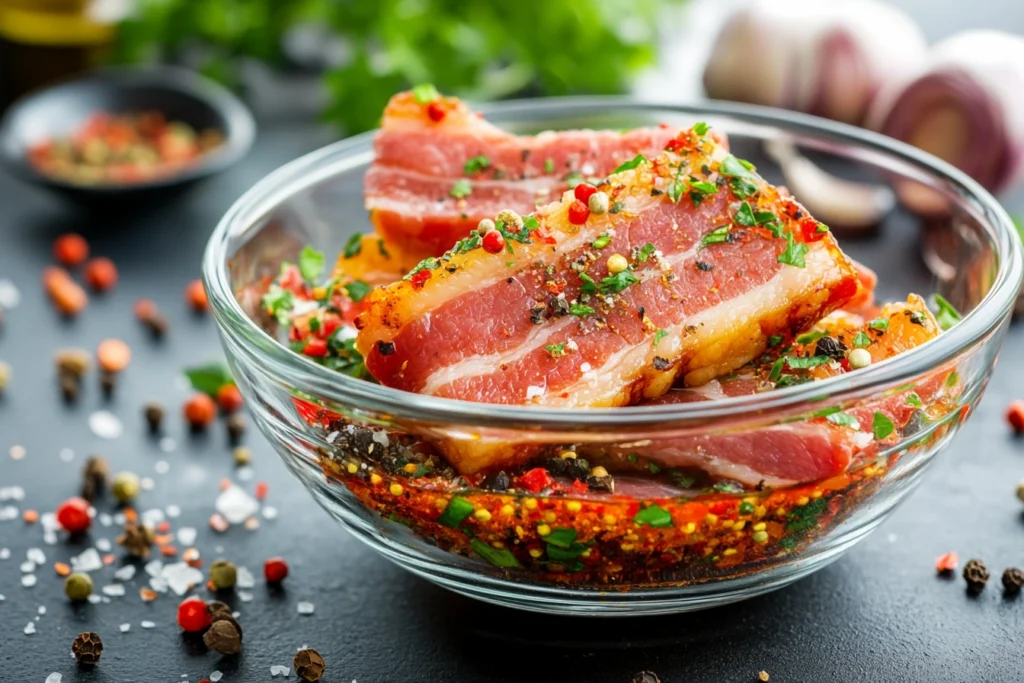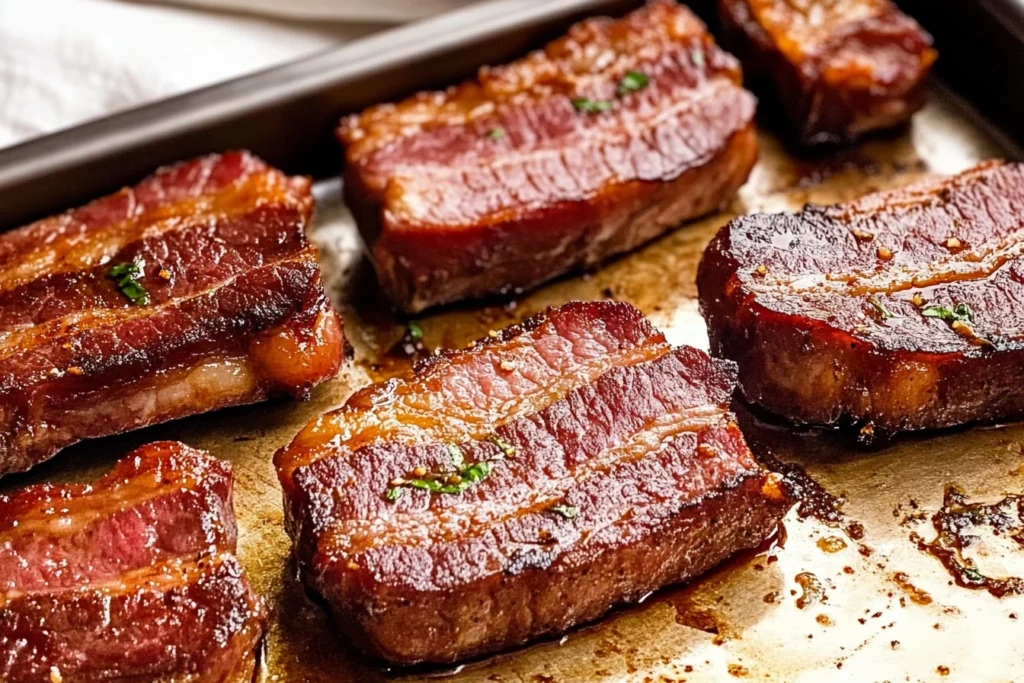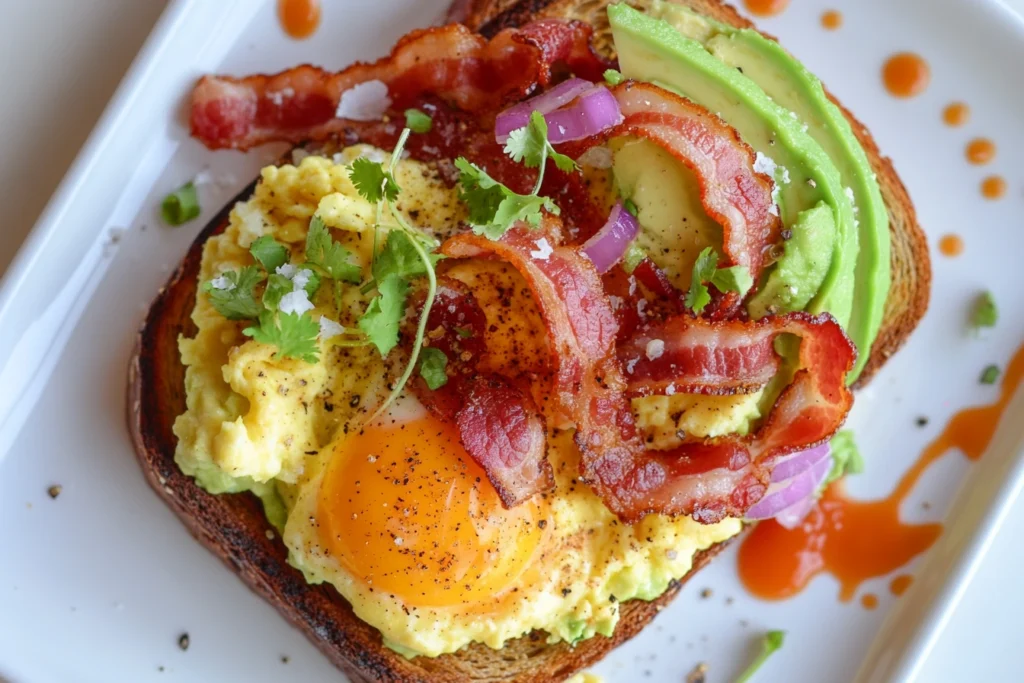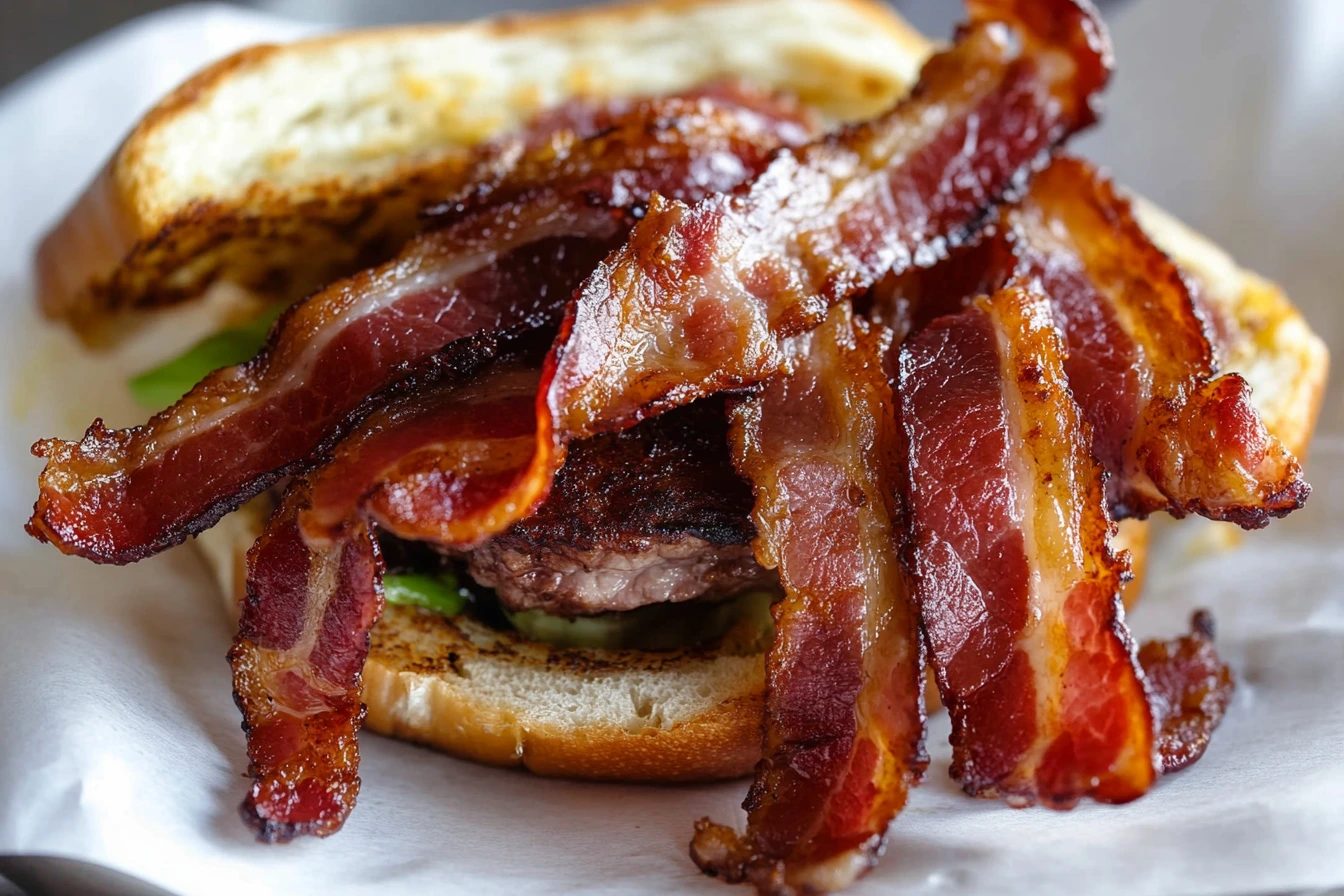Beef bacon is a delightful alternative to the traditional pork version. It’s made from carefully selected cuts of beef, cured and seasoned to perfection, offering a distinct flavor profile that many food enthusiasts adore. This beef bacon recipe aims to bring out the best in these cuts by combining traditional curing methods with modern culinary techniques. What makes it truly unique is its balance between lean meat and the rich, savory taste that bacon lovers crave.
Table of Contents
Nutritional Benefits of Beef Bacon
Health Advantages
One of the most compelling reasons to explore this beef bacon recipe is its nutritional profile. Compared to traditional pork bacon, beef bacon generally has a leaner cut and a higher protein content, making it an excellent choice for those who want to enjoy bacon without overindulging in saturated fats. This means you can savor the delicious taste while also benefiting from essential nutrients that support muscle maintenance and overall health.
Beef bacon is often celebrated for its balanced ratio of protein to fat, which can be particularly beneficial if you’re trying to follow a high-protein diet or maintain a healthy weight. Additionally, the curing process—when done right—helps preserve vital nutrients without the need for excessive additives, ensuring that your beef bacon recipe not only tastes great but also contributes positively to your dietary needs.
Comparative Analysis with Pork Bacon
When you compare beef bacon to pork bacon, several factors come to light. While pork bacon is renowned for its rich, buttery texture and flavor, beef bacon offers a more robust, meaty taste with a firmer bite. The lower fat content in beef bacon can be a significant advantage for those monitoring their caloric intake. Furthermore, beef bacon’s higher protein content supports a balanced diet, especially for active individuals looking to fuel their bodies with lean protein sources.
Another important aspect is the way beef bacon pairs with various ingredients. Its bold flavor makes it an excellent addition to salads, sandwiches, and even gourmet dishes, providing a versatile option for both everyday meals and special occasions. In short, while both types of bacon have their own merits, the beef bacon recipe offers a distinctive taste and nutritional edge that appeals to a wide range of culinary preferences.
Ingredients for the Ultimate Beef Bacon Recipe
Meat Selection and Quality
The cornerstone of any great beef bacon recipe is selecting the right cut of meat. For this recipe, opt for beef belly or a similarly marbled cut, as these provide the perfect balance of fat and lean muscle. It’s essential to source high-quality, grass-fed beef whenever possible, as this not only enhances the flavor but also ensures a healthier end product. Look for meat that has a bright, vibrant color and minimal connective tissue for the best results.
When shopping for beef, consider visiting a reputable butcher or a trusted local market. Quality beef not only improves the taste of your final dish but also plays a crucial role in the overall texture and consistency of your bacon. By investing in premium ingredients, you set the stage for a truly remarkable culinary experience that stands out from the ordinary.
Essential Spices and Marinades
A robust marinade is what transforms a simple cut of beef into a sensational bacon experience. Begin with a blend of salt, pepper, and a mix of other spices that complement the natural flavor of beef. Common additions include smoked paprika, garlic powder, and a hint of cayenne pepper to introduce a subtle kick. These ingredients help create a savory crust during cooking, locking in the moisture and enhancing the overall taste.
Remember, the quality of your ingredients is paramount. Don’t hesitate to experiment with different spice combinations until you find the perfect balance that suits your palate. The right marinade can make all the difference, turning a simple dish into a gourmet delight that will have everyone asking for seconds.
Step-by-Step Preparation Process
Marinating the Beef

The first critical step in our beef bacon recipe is the marination process. Start by trimming any excess fat from your chosen beef cut, ensuring you maintain a good balance between lean meat and marbling. Once prepared, create a marinade using a mix of kosher salt, black pepper, smoked paprika, garlic powder, and a touch of cayenne for that extra heat. Combine these with liquid ingredients like apple cider vinegar and Worcestershire sauce to create a well-rounded flavor base.
Place the beef in a large, resealable plastic bag or a non-reactive container and pour the marinade over it, making sure every inch of the meat is covered. Seal the bag or cover the container tightly and refrigerate for at least 12 hours—overnight is ideal. This extended marination period allows the spices and acids to work their magic, breaking down the muscle fibers and infusing the meat with intense flavor.
Cooking Techniques and Tips
After marination, it’s time to cook. Preheat your oven to 200°F (93°C) for a slow-cooking process that mimics traditional curing techniques. Arrange the beef on a wire rack placed over a baking sheet to allow even air circulation. Cooking the beef slowly ensures that it dries out slightly, intensifying the flavors while achieving that signature bacon-like texture.
While the oven method is popular, you might also try pan-frying for a different texture. If you opt for the skillet, use a heavy-bottomed pan over medium heat and cook the beef until it reaches your desired level of crispiness. Remember to turn the meat regularly to ensure even cooking on both sides. Whichever method you choose, patience is key. Rushing the process may result in a chewy, less flavorful outcome.
Here are a few quick tips to help you along the way:
- Even Slicing: Once your beef is cooked, let it cool slightly before slicing thinly. This ensures even texture and maximum flavor absorption.
- Resting Time: Allow the slices to rest for a few minutes after cooking. This helps redistribute the juices, making each bite succulent.
- Experiment: Don’t be afraid to adjust the seasoning. Taste a small piece during the process and tweak the spices if needed.
By following these steps carefully, you’re well on your way to mastering a beef bacon recipe that will impress both family and friends. Each stage, from marinating to cooking, is designed to build layers of flavor and ensure that the final product is nothing short of spectacular.
Cooking Methods for Perfect Beef Bacon
Oven-Baked Beef Bacon

When it comes to achieving that perfect crunch and flavor, the oven-baked method is a favorite for many. Preheat your oven to a low temperature and arrange your marinated beef on a wire rack. This method allows the heat to circulate evenly around the meat, slowly drying it out while intensifying the flavors. The low and slow approach ensures that the beef bacon retains its tenderness while developing a crisp exterior that truly mimics traditional bacon.
Oven baking is not only convenient but also minimizes the need for constant attention, letting you focus on other aspects of your meal prep. The controlled environment of the oven helps prevent overcooking and ensures that the bacon slices maintain their ideal texture throughout the cooking process.
Pan-Fried Alternatives
For those who love a quick, stovetop fix, pan-frying offers an equally delicious alternative. Use a well-seasoned cast-iron skillet and heat it over medium heat. Lay the beef slices carefully in the pan, ensuring they do not overlap, which allows each piece to crisp up evenly. Pan-frying can give you an extra layer of flavor, as the direct contact with the hot surface caramelizes the sugars in the marinade, creating delightful crispy edges.
Whichever method you opt for, remember that both techniques require a bit of attention. Stir occasionally, adjust the heat as needed, and always keep an eye on the color and texture of the bacon. The goal is to achieve a balance—a tender interior with a satisfyingly crunchy exterior that leaves a lasting impression on your taste buds.
Tips and Tricks for Flavor Enhancement
Spicing Up Your Recipe
If you’re looking to add a little extra oomph to your beef bacon recipe, consider experimenting with different spice blends. While the classic combination of salt, pepper, and smoked paprika forms a great base, you can elevate the flavor by incorporating herbs like thyme or rosemary. A dash of cumin or even a hint of brown sugar can create a beautiful contrast, balancing savory and sweet notes in every bite.
Experimenting with spices is all about personal taste, so don’t be afraid to get creative. Try adding a touch of chili flakes for heat or a splash of maple syrup for a subtle sweetness. The key is to taste as you go and adjust the ingredients until you achieve your ideal flavor profile. These tweaks not only add complexity but also give your beef bacon a signature twist that’s uniquely yours.
Presentation and Garnishing
Presentation plays a pivotal role in any dish. Even a fantastic beef bacon recipe can benefit from a little garnish to elevate its appeal. Consider serving your bacon with a sprinkle of freshly chopped herbs or a side of tangy dipping sauce. Arranging the slices neatly on a platter with a few lemon wedges or a drizzle of high-quality olive oil can transform the dish into a visual feast.
Here are a few quick presentation tips:
- Garnish Wisely: Use fresh herbs like parsley or chives to add color.
- Side Dips: Serve with a homemade mustard or a spicy aioli.
- Creative Plating: Arrange the bacon in a fan shape or alongside complementary dishes for a balanced plate.
These small touches make a significant impact on the overall dining experience, ensuring that your beef bacon not only tastes incredible but also looks appealing.
Variations on the Beef Bacon Recipe
Spicy Beef Bacon
For those who love a kick in their meal, the spicy variation of the beef bacon recipe is a must-try. By increasing the amount of cayenne pepper or incorporating chili powder into your marinade, you can create a version that’s sure to excite your taste buds. The heat from the spices melds beautifully with the rich flavor of the beef, resulting in a bold, dynamic dish that stands out at any breakfast or brunch table.
Sweet and Savory Options
If you’re in the mood for something that balances both sweet and savory, consider adding a touch of brown sugar or even a drizzle of honey to your marinade. This twist creates a delightful contrast, enhancing the natural flavors of the beef while offering a subtle sweetness that pairs wonderfully with its smoky undertones. Experimenting with these variations can lead to exciting new takes on the traditional beef bacon recipe, perfect for impressing your guests or simply treating yourself.
Serving Suggestions and Pairings
Breakfast Combinations

Beef bacon is a versatile ingredient that can elevate any breakfast. Serve it alongside scrambled eggs, avocado toast, or even a hearty grain bowl. Its robust flavor pairs wonderfully with both sweet and savory breakfast items, making it a popular choice for those who appreciate a well-rounded morning meal. For a classic combination, wrap your bacon around a slice of grilled tomato or serve it on top of a stack of pancakes drizzled with a light maple syrup.
Lunch and Dinner Applications
Beyond breakfast, beef bacon can be a fantastic addition to salads, sandwiches, and even gourmet burgers. Its unique texture and flavor profile make it an excellent topping for a crisp Caesar salad or a flavorful BLT with a twist. Incorporate it into your favorite pasta dish or sprinkle it over a baked potato to add a satisfying crunch. The versatility of this beef bacon recipe means it can transition effortlessly from a morning delight to a key component of your main course.
Storage, Preservation, and Leftover Ideas
Proper Storage Techniques
Once you’ve prepared your beef bacon, storing it correctly is crucial to maintaining its flavor and texture. Allow the bacon to cool completely, then store it in an airtight container in the refrigerator. For longer preservation, you can also freeze the slices—just make sure to use freezer-safe packaging. Proper storage not only helps retain the bacon’s crunch but also makes it convenient for use in future meals.
Creative Ways to Repurpose Leftovers
Leftover beef bacon can be repurposed in a variety of creative ways. Chop it up and sprinkle it on salads, incorporate it into a hearty soup, or even use it as a flavorful topping on your favorite pizza. These ideas ensure that none of your delicious creation goes to waste, and each meal gets a little upgrade from the savory notes of beef bacon.
Frequently Asked Questions (FAQs
- What makes beef bacon different from pork bacon?
Beef bacon is made from beef cuts rather than pork. It tends to be leaner with a distinct meaty flavor and a firmer texture, making it a great alternative for those who prefer or require a pork-free option. - How long should I marinate the beef for the best flavor?
It’s best to marinate the beef for at least 12 hours, though marinating overnight is ideal. This extended time allows the spices and liquids to deeply penetrate the meat, ensuring a robust flavor. - Can I adjust the seasoning in the marinade?
Absolutely! One of the beauties of this beef bacon recipe is its versatility. Feel free to experiment with different spices and herbs to suit your personal taste. Just remember to taste a small portion during the process and adjust accordingly. - What cooking method yields the best texture?
Both oven-baking and pan-frying yield excellent results, though they offer different textures. Oven-baking provides a more even crispiness, while pan-frying can enhance caramelization for extra flavor. Choose the method that best suits your desired outcome. - How do I store leftover beef bacon?
After cooling, store the beef bacon in an airtight container in the refrigerator. It will keep well for several days. For longer storage, freeze the slices in a freezer-safe bag, and thaw them in the refrigerator when needed. - Is beef bacon a healthier option than pork bacon?
Generally, beef bacon tends to be leaner and higher in protein compared to traditional pork bacon. However, nutritional values can vary depending on the cut and preparation methods, so it’s best to check specific details based on your ingredients.
Conclusion
In wrapping up, the beef bacon recipe featured here is more than just a cooking guide—it’s an invitation to explore a world where tradition meets innovation. From its rich history and nutritional advantages to detailed preparation methods and creative serving suggestions, this guide provides everything you need to craft a dish that delights both the palate and the eyes.
Looking for perfect pairings? Try a side of loaded baked potato salad or elevate your meal with a cottage cheese pizza bowl. If you’re a steak lover, don’t miss our guide to delmonico steak or the secrets to a mouthwatering steak sandwich.
Whether you’re cooking for yourself or entertaining guests, this ultimate sizzle of beef bacon is sure to become a favorite staple in your culinary repertoire. Pair it with a refreshing skinny margarita or end on a sweet note with banana bread cinnamon rolls.
Enjoy the process, experiment with flavors, and most importantly, savor every bite of your delicious creation!

